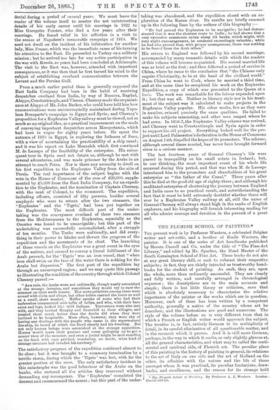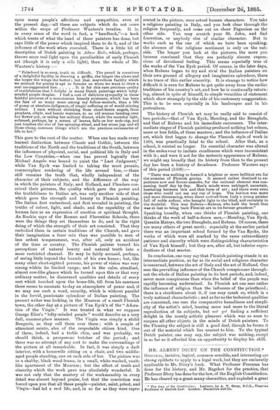THE FLEMISH SCHOOL OF PAINTING.*
THE present work is by Professor Wauters, a celebrated Belgian writer and art-critic, and a brother of Emile Waders, the painter. It is one of the series of Art handbooks published by Messrs. Cassell and Co. under the title of "The Fine-Art Library," and edited by Mr. Sparkes, the Head Master of the South Kensington School of Fine Art. These books do not aim at any great literary skill, or seek to exhaust their respective subjects ; in fact, they are chiefly intended as trustworthy hand- books for the student of painting. As each, they are, upon the whole, more than ordinarily successful. They are clearly and fully written, and carefully arranged in chronological sequence ; the descriptions are in the main accurate and simple ; there is bat little theory or criticism, save that which is absolutely necessary to characterise the relative importance of the painter or the works which are in question. Moreover, each of them has been written by a competent authority, generally a native of the country whose art he describes ; and the illustrations are good and numerous. The style of the volume before us is very different from that in which a French or English writer would approach the subject. The treatise is, in fact, entirely German in its multiplicity of detail, in its careful elimination of all questionable matter, and in the research which it proves. And it is still more German, perhaps, in the way in which it omits, or only slightly glances at, all the general characteristics, and what may be called the senti- mental and spiritual side, of Flemish art. The peculiar place of this painting in the history of painting in general, its relations to the art of Italy on one side and the art of Holland on the other, its affinities with the nature and the life of those amongst whom it was practised, its peculiar limitations, draw- backs, and excellences, and the reason for its strange hold • The Flemiah School of Penfing. By Professor A. Wantons. London : Cassell and Co.
upon many people's affections and sympathies, even at the present day,—all these are subjects which do not come within the scope of Professor Wauters's treatise. It is, in every sense of the word in fact, a " handbook,"—a book which treats of what the hand of these painters has done, bat says little of the power which inspired them to do it, and of the influence of the work when executed. There is a little bit of description of Dutch painting in Adam Bede, which, perhaps, throws more real light upon the peculiarities of early Flemish art (though it is only a side light), than the whole of Mr. Wauters's history :—
"Falsehood is so easy, truth so difficult. The pencil is conscious of a delightful facility in drawing a griffin, the longer the claws and the larger the wings the better ; but that marvellous facility which we mistook for genius is apt to forsake us when we want to draw a real unexaggerated line It is for this rare precious quality of truthfulness that I delight in many Dutch paintings which lofty. minded people despise. I find a sort of delicious sympathy in these faithful pictures of a monotonous homely existence, which has been the fate of so many more among my fellow-mortals, than a life of pomp or absolute indigence, of tragic suffering or of world-stirring actions. I turn without shrinking from cloud-borne angels, from prophets, sibyls, and heroic warriors, to an old woman bending over her flower-pot, or eating her solitary dinner, while the noonday light, softened, perhaps, by a screen of leaves, falls on her mob-cap, and just touches the rim of her spinning.wheel, and her stone jug, and all those cheap, common things which are the precious necessaries of life to her."
This goes to the root of the matter. When one has made every learned distinction between Classic and Gothic, between the traditions of the North and the traditions of the South, between the influences of physical, social, and political life in Italy and the Low Countries,—when one has proved logically that Michael Angelo was bound to paint the "Last Judgment," while Van Eyck was limited to taking the most prosaic, commonplace rendering of the life around him, — there still remains the truth that, wholly independent of the character of their subjects, and the difference of the way in which the painters of Italy, and Holland, and Flanders con- ceived their pictures, the quality which gave the power and the truthfulness to Italian art, was only another side of that which gave the strength and beauty to Flemish painting. The Italian first understood, and first revealed in painting, the truths of colour, light, and shade, and the capability of the human face as an expression of emotion or spiritual thought. As Ruskin says of the Roman and Florentine Schools, these were the things they set themselves to do, and in the right doing of which the strength of their art consisted. That they embodied them in certain traditions of the Church, and gave their imagination a freer rein than was possible to men of less ardent temperament, was, after all, only an accident of the time or country. The Flemish painter turned his perceptions of natural beauty and natural truth into a more restricted channel. He may be fairly accused, perhaps, of seeing little beyond the bounds of his own house; but, like many other short-sighted persons, his power of vision was very strong within its limited range ; and in the calm, steadfast, almost cow-like glance which he turned upon this or that very ordinary matter, he discovered qualities and details of every sort which touched upon the home-life, till from his canvases there seems to emanate to-day an atmosphere of peace and, if we may use such a word, security, which is without parallel in the fervid, passionate splendour of Italian painting. The present writer was looking, in the Museum of a small Flemish town, the other day at a picture of Van Eyck's of the "Adora- tion of the Virgin." It was treated in what we suppose George Eliot's "lofty-minded people" would describe as a very dull, commor place manner. The Virgin was simply a stolid Brugeois, as they call them over there ; with a couple of attendant saints, also of the respectable citizen kind. One of them, indeed, had• a treble chin, and was probably, we should think, a prosperous butcher of the period ; and there was no attempt of any sort to make the surroundings of the picture at all remarkable. In fact, it was simply a dark interior, with a housewife sitting on a chair, and two middle- aged people standing, one on each side of her. The picture was in a shabby, black wood frame, in a small, white-washed, vault- like apartment of the Museum ; but the effect of truth and sincerity which the work gave was absolutely wonderful. It was not only that the mastery of the workmanship in every detail was almost beyond praise, but that the conviction was forced upon you that all these people—painter, saint, priest, and Virgin—had led a real life, and, in so far as they were repre-
sented in the picture, were actual human characters. You take a religions painting in Italy, and you look clear through the religion frequently, and come out on sheer Paganism on the other side. You may scratch your St. John, and find Lucretius, or anybody else of similar character. But in works such as the one of which we have been speaking, the absence of the religious sentiment is only on the out- side. The longer you look at the pictures, the more you become convinced that they are perfectly sincere expres- sions of devotional feeling. This seems especially tree of the works of the Van Eyck period. Of course. in the later days, when Rubens began to try and rival the Italian painters on their own ground of allegory and imaginative splendour, there is no trace of this earlier sincerity. It is strange to notice how difficult it is even for Rubens to get quite away from the earlier traditions of his country's art, and how he is continually return- ing, almost in spite of himself, to simple veracities of statement which show strangely by the side of his customary exaggeration. This is to be seen especially in his landscapes and in his portraiture.
The history of Flemish art may be really said to consist of two periods,—that of Van Eyck, Memling, and the Breughels, and that of Rubens and his immediate successors. The inter- mediate stages of Flemish painting produced nothing but echoes, more or less futile, of these masters ; and the influence of Italian art, which first began to change the Flemish style of work in 1480, was practically fatal to the school. After that, as a school, it existed no longer. Its essential character was altered in the endeavour to imitate excellences which were inconsistent with it ; and were it not for the meteoric appearance of Rubens, we might say broadly that its history from then to the present day has been a history of decadence. Professor Wauters says of this period (1608) :—
"There was nothing to foretell a brighter or more brilliant era for the remains of Flemish genius. It seemed rather destined to ex- perience new and fiercer assaults, for the national element was con- suming itself day by day. Men's minds were unhinged, uncertain, hesitating between this and that form of art ; and there were even those who could not see any ray of hope. The horizon was more and more threatening, when there arrived from Italy a young painter full of noble ardour, who brought light to the blind, and certainty to the doubtful. This was Rubens—Rubens, who held the brash that was at last to bring back Flemish art to its former grandeur."
Speaking broadly, when one thinks of Flemish painting, one thinks of the work of half-a-dozen men,—Memling, Van Eyck, Quentin Matsys, the two Breughels, and Rubens. Of course, there are many others of great merit ; especially at the earlier period there was an important school formed by the Van Eycks, the works of which were all marked by the same extraordinary patience and sincerity which were distinguishing characteristics of Van Eyck himself ; but they are, after all, but inferior repro- ductions of that master.
In conclusion, one may say that Flemish painting stands in an intermediate position, as far as its social and religious character is concerned, between the art of Italy and the art of Holland. One sees the prevailing influence of the Church conspicuous through- out the whole of Italian painting in its best periods, and, indeed, never more conspicuous than when the belief of the people was rapidly becoming undermined. In Flemish art one sees rather the influence of religion than the influence of the priesthood ; there is a sturdiness about it, if one may speak so, which is a truly national characteristic ; and as far as the technical qualities are concerned, one sees the comparative homeliness and simpli- city of the artist's mind, leaning more and more to the literal reproduction of its subjects, but not yet finding a sufficient delight in the merely artistic pleasure which was so soon to surpass all other objects in the minds of Dutch painters. To the Fleming the subject is still a good deal, though he forms it out of the material which lies nearest to him. To the typical Dutch painter, one may say, the subject was nothing, except in so far as it afforded him an opportunity to display his skill.



































 Previous page
Previous page